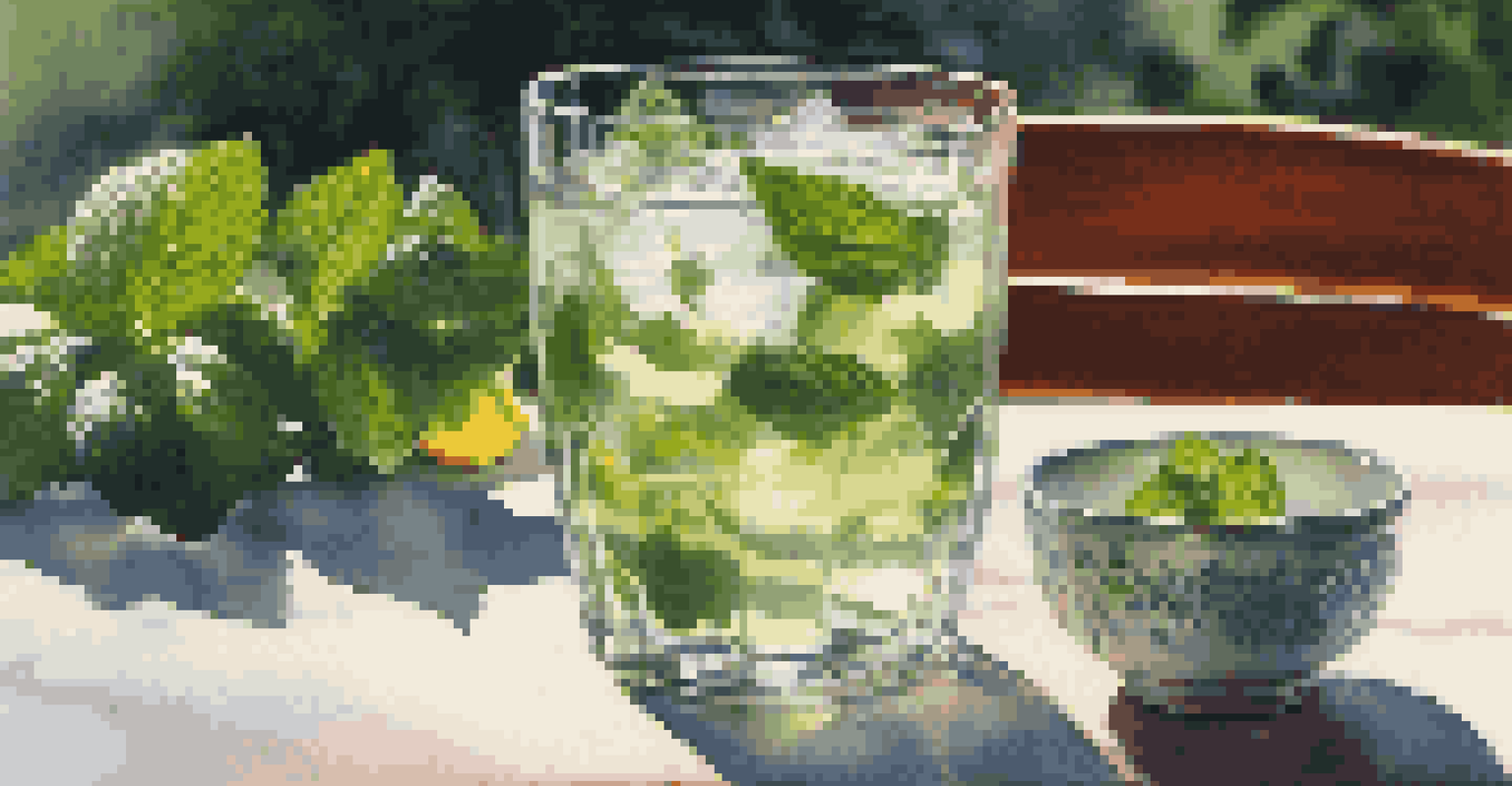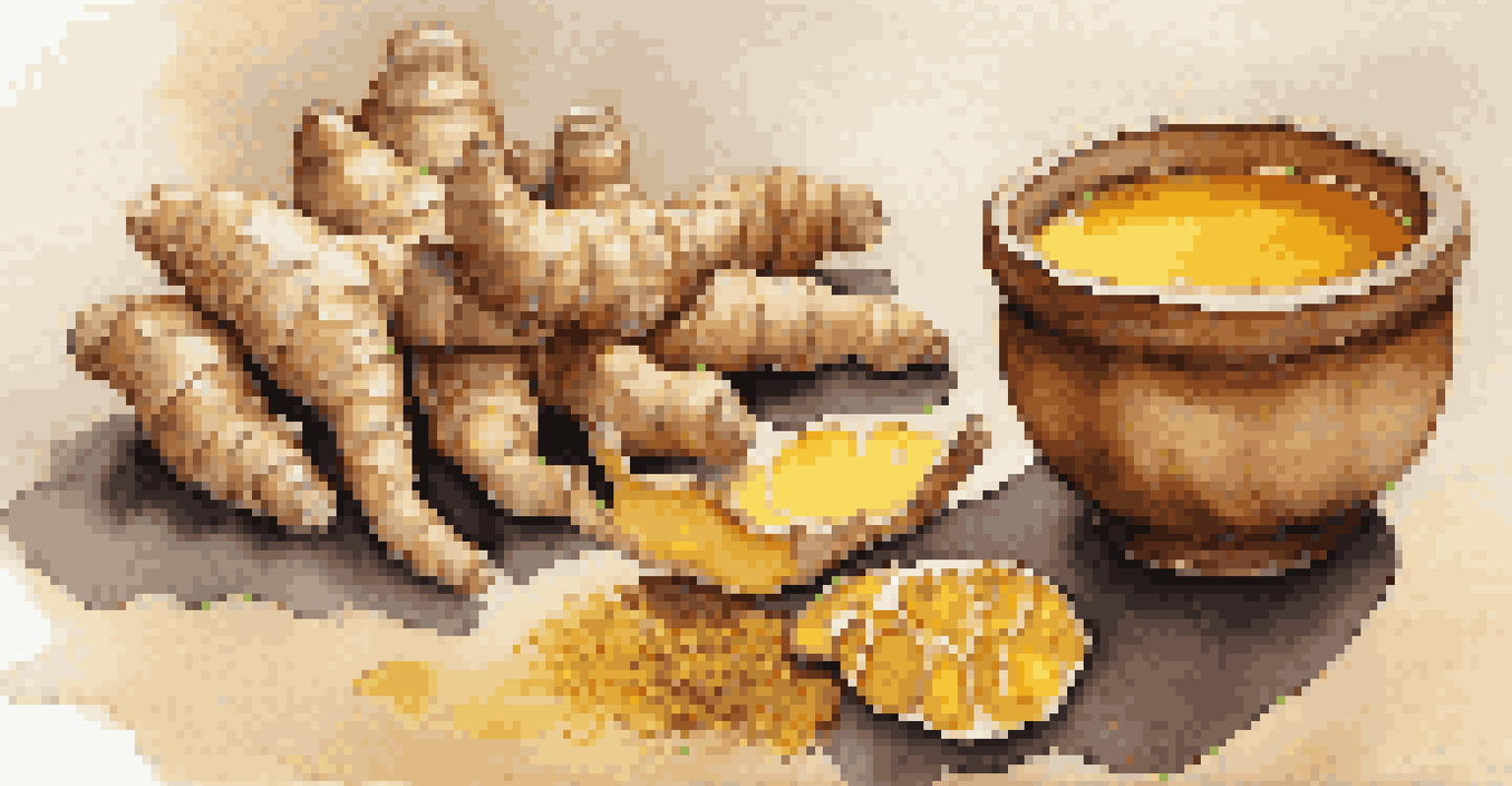Herbal Infusions: Easy Recipes for Home Brewing

What Are Herbal Infusions and Their Benefits?
Herbal infusions are beverages made by steeping herbs in hot water, similar to tea. They are not only flavorful but also packed with various health benefits, depending on the herbs used. For example, chamomile is known for its calming properties, while peppermint can help with digestion.
Herbs are the friend of the physician and the pride of cooks.
These infusions can be a delightful alternative to traditional teas, offering a wide range of flavors and aromas. They can be enjoyed hot or iced, making them versatile for any season. Plus, brewing your own herbal infusions allows you to experiment with different combinations and discover what you love best.
Beyond just taste, herbal infusions can support wellness. Many herbs have been used for centuries in traditional medicine, and infusing them into a drink can provide a simple way to incorporate their benefits into your daily routine.
Essential Tools for Brewing Herbal Infusions
To get started with herbal infusions, you don't need much—just a few essential tools. A teapot or heatproof container is perfect for steeping your herbs, while a fine mesh strainer will help separate the liquid from the plant material. If you prefer single servings, a tea infuser can be a convenient option.

An electric kettle or a stovetop kettle will also come in handy for boiling water. The right temperature is crucial, as different herbs require different steeping temperatures to unlock their flavors and benefits. Don't forget to have a measuring spoon or scale for precise herb measurements.
Herbal Infusions Boost Wellness
Herbal infusions offer a flavorful way to enjoy the health benefits of various herbs, like chamomile for calming and peppermint for digestion.
Lastly, a notebook can be useful for jotting down your infusion experiments and noting which combinations you enjoy the most. This way, you can recreate your favorite blends and track your herbal adventures.
Classic Chamomile Infusion Recipe
Chamomile is a classic choice for herbal infusions, known for its soothing qualities. To brew a simple chamomile infusion, start by boiling water and measuring about 1-2 teaspoons of dried chamomile flowers per cup of water. Once the water is ready, pour it over the flowers and let it steep for about 5 minutes.
The greatest gift of the garden is the restoration of the five senses.
After steeping, strain the infusion to remove the flowers, and you’re left with a fragrant, golden drink. You can enjoy it as is, or add a touch of honey or lemon for extra flavor. The calming aroma of chamomile makes it perfect for a relaxing evening ritual.
This infusion not only tastes great but can also help promote restful sleep. It’s an excellent way to unwind after a long day, making it a staple in many households.
Refreshing Peppermint Infusion Recipe
Peppermint is another popular herb known for its refreshing taste and digestive benefits. To make a peppermint infusion, use fresh or dried peppermint leaves—about 1 tablespoon per cup of water works well. Boil your water and pour it over the leaves, allowing it to steep for 5-10 minutes for a stronger flavor.
Strain the infusion and enjoy it hot, or let it cool and serve it over ice for a refreshing summer drink. You can also enhance it with a splash of lemon or a sprig of fresh mint for garnish. The invigorating scent and flavor of peppermint can awaken your senses, making it a fantastic choice for any time of day.
Simple Tools for Brewing
You only need a few essential tools, such as a teapot and a fine mesh strainer, to easily brew your own herbal infusions at home.
In addition to its taste, peppermint is often used to soothe stomach discomfort, making this infusion a great digestive aid after meals.
Invigorating Ginger and Turmeric Infusion Recipe
For a warming and invigorating infusion, consider combining ginger and turmeric. This duo is celebrated for its anti-inflammatory properties and can be a wonderful pick-me-up. To brew this infusion, slice a small piece of fresh ginger and add it to a cup of boiling water, along with a pinch of ground turmeric.
Let the mixture steep for about 10 minutes. You can strain it if desired, and add honey or lemon to enhance the flavor. This infusion not only warms you up but also provides a boost to your immune system, making it perfect for colder months.
Enjoy this infusion in the morning to kickstart your day, or sip it in the afternoon for an energy boost. It's a great way to incorporate these powerful roots into your diet.
Floral Hibiscus Infusion Recipe
Hibiscus is a vibrant flower known for its tart flavor and beautiful color. To create a hibiscus infusion, add 1-2 teaspoons of dried hibiscus flowers to boiling water and let it steep for about 10-15 minutes. The longer you steep, the more intense the flavor will be.
After steeping, strain the infusion and taste it. If you prefer sweetness, adding a bit of honey or agave syrup can balance the tartness. This infusion is delightful served hot, but it can also be chilled and served over ice for a refreshing summer drink.
Creative Flavors from Combinations
Mixing different herbs can lead to unique and personalized infusion flavors, allowing you to experiment and discover your favorite blends.
Hibiscus is rich in antioxidants and is known for its potential to lower blood pressure, making this infusion not only delicious but also beneficial for your health.
Creative Combinations for Unique Infusions
Once you feel comfortable with basic herbal infusions, it’s time to get creative! Combining different herbs can lead to unique flavors and benefits. For example, blending chamomile and lavender creates a calming drink perfect for bedtime, while mixing ginger and lemon can provide a zesty, immune-boosting infusion.
Think about the flavors you enjoy and how they might work together. You can also experiment with adding spices like cinnamon or cardamom for an extra kick. The possibilities are endless, so don’t be afraid to try something new!

Creating your own herbal infusion blends can be a fun and rewarding experience. You might even discover your signature recipe that friends and family will love.
Tips for Storing and Using Herbs for Infusions
To make the most of your herbal infusions, proper storage of your herbs is crucial. Keep dried herbs in airtight containers, away from direct sunlight or moisture, to preserve their flavor and potency. Glass jars or dark tins work well for storage.
When using fresh herbs, it’s best to use them shortly after purchasing. However, you can also keep them in the fridge, wrapped in a damp paper towel, to extend their freshness. If you have an abundance of herbs, consider drying them for future use.
Lastly, always remember to label your containers with the herb name and date of storage. This simple practice will help you keep track of your herbs and ensure you’re using them while they’re at their best.